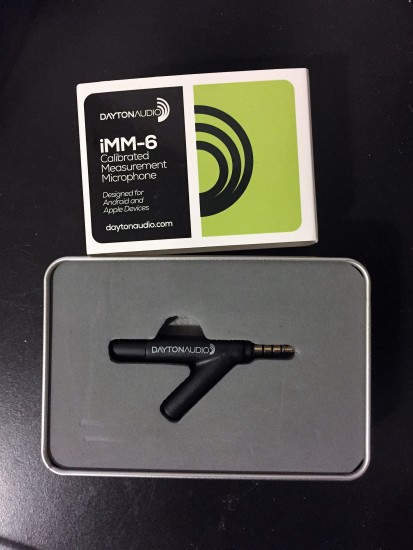UPDATE:
March 9, 2017
In the end, Michael bought a Dayton Audio iMM-6 Calibrated Measurement Microphone. This little mic is great for recording bees. It’s compact, and plugs right into your phone! I worked with it a bit when we first got it, taking some test recordings using my Tonal Energy tuner on my smart phone. It works fairly well, but it doesn’t have much range.
I am planning on working with Chris, a graduate student in the lab, to record the bees while he studies them. Chris is working with bees to measure how much weight they can lift, and how lifting weight over and over again impacts their bodies – do they build muscle, or get better at lifting more weight?
I worked with him on Thursday, March 2, 2017. He taught me how to tie “belts” on to the bumblebees, and attach weights (a string with beads tied to it at specific intervals) to them. This is the closest I have been to the bees! My plan is to record them through a small hole in the flight chamber, and to hopefully get started next week. I’ll take more pictures then!
Finally, I have found a great application for my bee recordings. I have been commissioned by soprano Cristin Colvin to write a piece for voice and my instrument (oboe), and she is excited to include my bee sounds. The piece will explore what I learn from recording bees, and highlight the importance of taking care of bumblebees and their environment.
Original Post:
The end of last semester was fairly uneventful. I continued to care for the bees while Michael and I brainstormed project ideas. We finally decided to create a sound library of bee noises, and hopefully use that to study bee communication. I did quite a bit of research, trying to figure out what other scientists have done, and what might work best in our lab.
Article #1
Hissing in bumblebees: an interspecific defence signal
These scientists were awesome and listed exactly what they used to record their bees (using an accelerometer (Bruel & Kjaer 4380), which was mounted in the middle of the nest, and a microphone (B&K 4134 attached to a preamplifier B&K 2639)) But this microphone is pretty expensive, and I don’t quite understand the set-up. On the bright side, this company’s microphones are capable of recording .1Hz – 140kHz. It’s worth looking into further if we want more accuracy in high ranges… probably?
Article #2:
“Comparative Bioacoustical Studies on Flight and Buzzing of Neotropical Bees”
This article says that they used a “sensitive directional microphone.” Later, it states that they used a sound analyzer on a cell phone, a microphone, and a recording device. They weren’t specific at all.
Article #3:
“Buzz pollination in eight bumblebee-pollinated Pedicularis species: Does it involve vibration induced triboelectric charging of…”
In this article it states that they used acoustic recording to measure wingbeat frequency, and flight tones were recorded digitally (basically recorded into a computer, no mention of what type of microphone they used) and analyzed with RavenLite Sound Analysis software.
What I think about the Articles
I feel like there’s still a lot more useful information in the articles I looked at over the week, but right now it’s not incredibly helpful… I need to read them more in depth, but I was more concerned about getting to the bottom of this microphone business.
I did search the internet for “how to record bee sounds” and that’s what lead me to those articles.
Microphones I looked at:
BM-800 Professional Studio Condenser Sound Recording Microphone BM-800 Professional Studio Condenser Sound Recording Microphone (must be careful if/when ordering, there are two versions and the one that requires phantom power is much higher quality for the same price)
Typical condenser microphone, requires phantom power, cheap but good quality, 20Hz-20kHz, designed to minimize background noise and isolate the source, regular sized microphone
Shure Mv88 (and a couple other options here)
Small condenser microphone, can plug into phone, more expensive, 20Hz-20kHz
I also looked at other microphones, but none of them seemed like a great fit.
Finally, as far as ultrasonic sound recording, not many microphones are equipped for that (it’s outside of our hearing range, so why would we need it?)
Options for Ultrasonic Recording:
http://www.wildlife-sound.org/equipment/technote/micdesigns/ultrasonic.html (cheap option, DIY?)
http://www.wildmountainechoes.com/equipment/options-for-recording-ultrasounds/
http://www.batmanagement.com/Ordering/acoustic/hardware6.html (using bat detectors to analyze high frequency if it’s there – much cheaper than an actual mic, but I don’t know how it works)
